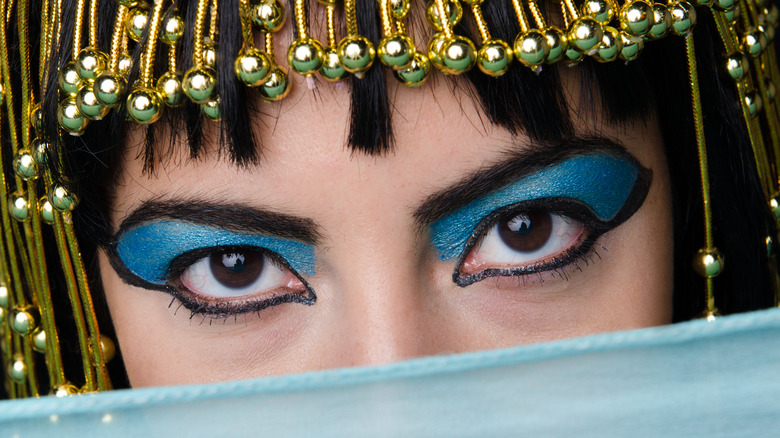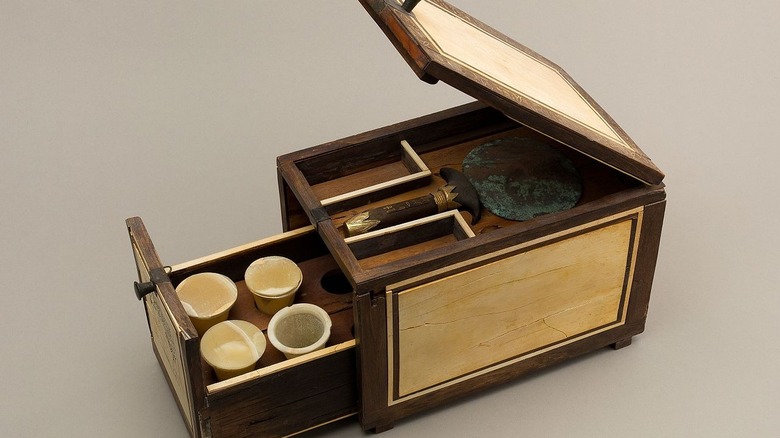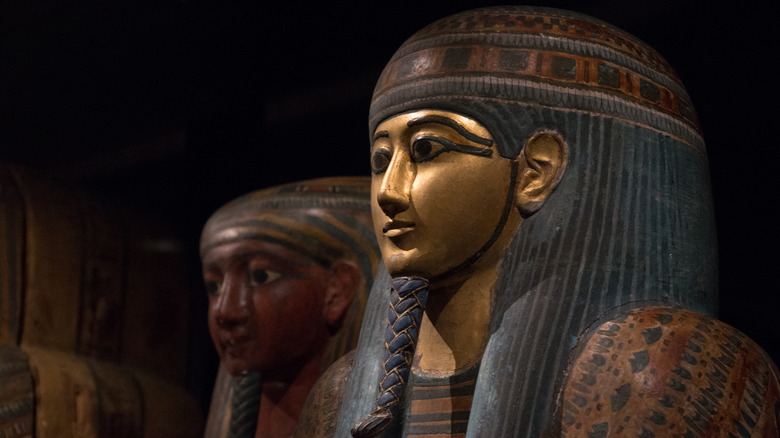The History Of Makeup In Ancient Egypt Explained
We can all imagine Cleopatra's smoky, cat-like mascara and curved blue eyeshadow, right? Thanks, Elizabeth Taylor. But as cool as that look is, would you be surprised to learn that it's actually not too far off from the real historical thing? Add green to your choices of color, desaturate the intensity, and voilà: instant ancient makeup tutorial for YouTube.
Yes, the ancient Egyptians took their makeup very, very seriously, both men and women alike, applying foundation, rouge, lipstick, eyeshadow, mascara, and everything in between, as well as exfoliating. As World History explains, their use of cosmetics, perfumes, toothpaste, ointments, and so forth goes far beyond simple aesthetics or beauty. It's most accurate to think of cosmetics, health, and spirituality all fused together into one holistic healthcare bundle.
It's impossible to account for the cosmetic habits of the entirety of ancient Egyptian history through 3,100 years and 31 dynasties of evolving culture (as outlined on Australian Museum). We at least know that by the Middle Kingdom (2125-1650 BCE) daily beauty regimens were as intricate and ritualized as they were commonplace, as CNN explains. And we don't just mean wealthy people; we mean commoners, too. Lower classes likely followed the same routines, just with less expensive materials or tools — a wood applicator instead of ivory, perhaps. We know this because of the sheer number of artistically-fashioned containers and tools found at archaeological sites: alabaster and calcite jars, bronze mirrors, glass or gold palettes, and much more.
A 4,000-year-old beauty and healthcare regimen
As CNN outlines, it's amazing how similar Egyptian beauty regimens were to our own, 4,000 years later: exfoliation and washing, perfume and deodorant, creams and powders, eyeshadow and mascara, and finally lipstick.
Dead Sea salt exfoliation was a common way to soften the skin, or milk-and-honey baths followed by the application of spice-infused oils and creams. Incense pellets could also be rolled under the arms as deodorant. "Kyphi" was a wildly popular perfume made from "frankincense, myrrh, mastic, pine resin, cinnamon, cardamom, saffron, juniper, mint," and more, as World History states. Ingredients were so rare, though, that is was often only used in temples, and folks had to find substitutes. They also waxed, using honey and sugar.
Eye makeup was particularly important. The Egyptian word for "makeup palette" derives from their verb "to protect," which meant both spiritual protection from "the evil eye" and practical protection from the glare of sunlight. Hence the heavy "kohl" eyeliner: twin dark lines above and below the eye. Eyeshadow was made by mixing powdered malachite (a green stone) or azurite (a blue stone) with animal fat or vegetable oils. For lipstick, folks preferred bright red, such as Cleopatra's use of ground beetles to get the shade she wanted.
Palettes were often shaped like animals. It was believed that grinding materials on such a palette granted the user an animal's power, such as fertility from tilapia, per the Natural History Museum of Utah.
A spiritual practice for the dead
As CNN explains, makeup and healthcare weren't only for the living. People undergoing mummification for the journey to the afterlife were cared for according to the same beauty regimens they undertook when alive. Other ointments were then added as a way to anoint the body, in addition to embalming fluids. Finally, the outside of sarcophagi were painted with those now-famous illustrations depicting the mummified person within. As quoted on Google Arts and Culture, this was a way "to strengthen the spirit of the mummy and guard the soul from evil spirits on its way to the afterworld." In general, maintaining a clean body was a way to prepare for the afterlife, as World History states.
Of course, what true beauty and healthcare regimen would be complete without toothpaste, breath mints, wig removal, and nightly baths? During the day folks would suck on breath mints made from powdered frankincense, cinnamon, melon, pine seeds, and cashews bound together by honey. Toothpaste existed all the way back to pre-dynastic Egypt (before 3100 BCE), and consisted of mint, rock salt, pepper, and dried iris flower. Toothbrushes, which came later, used bristles made from thinly cut plant strips.
Wigs were sometimes worn for events where a particular hairstyle was needed. The wealthy used wigs made from human hair, later mixed with horse hair, sometimes intertwined with gems or jewelry. At the end of the day, folks removed their wigs and washed off their makeup in a nightly bath.


